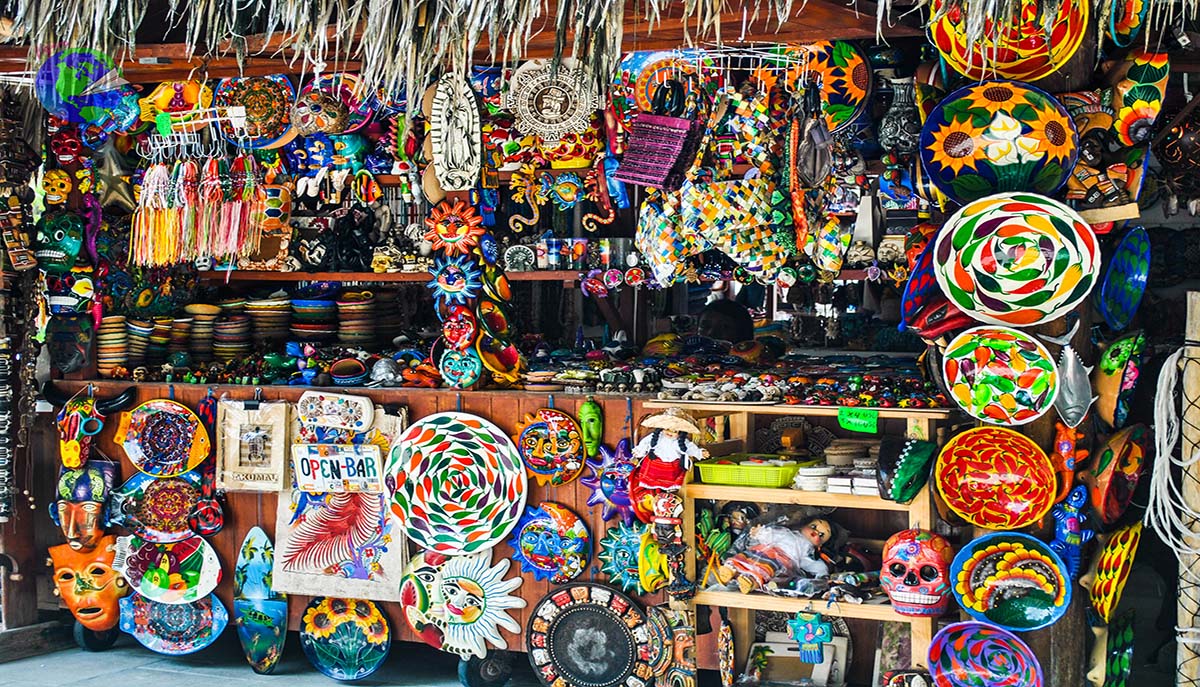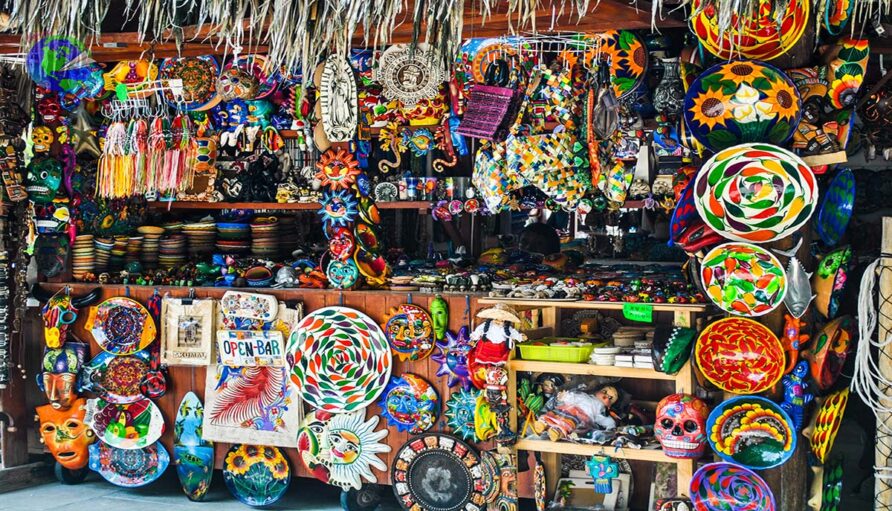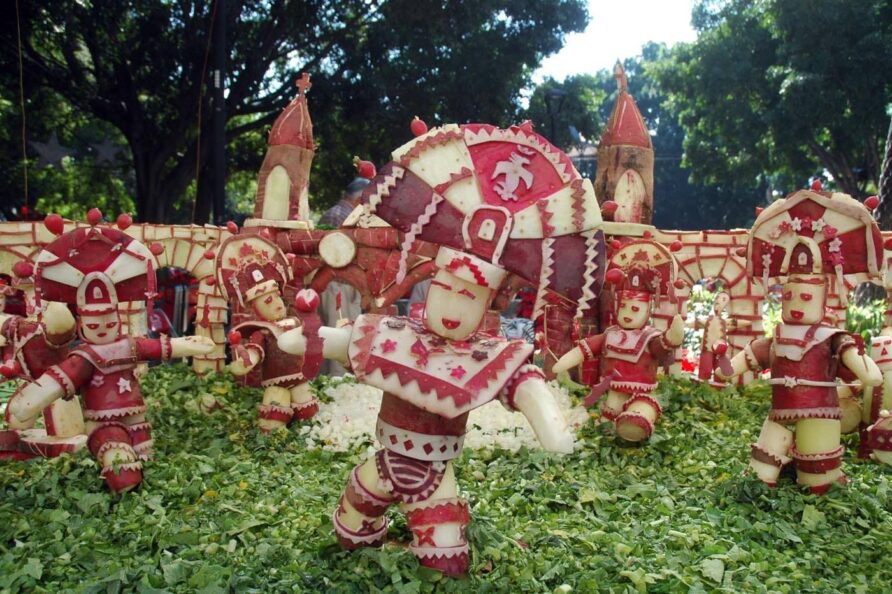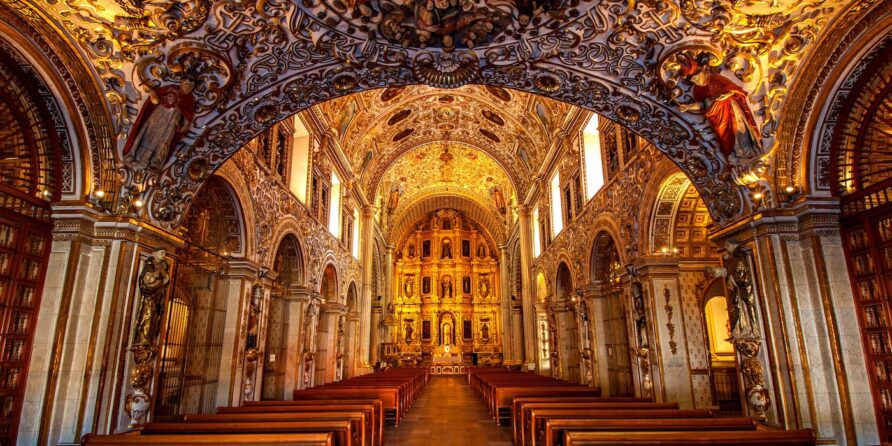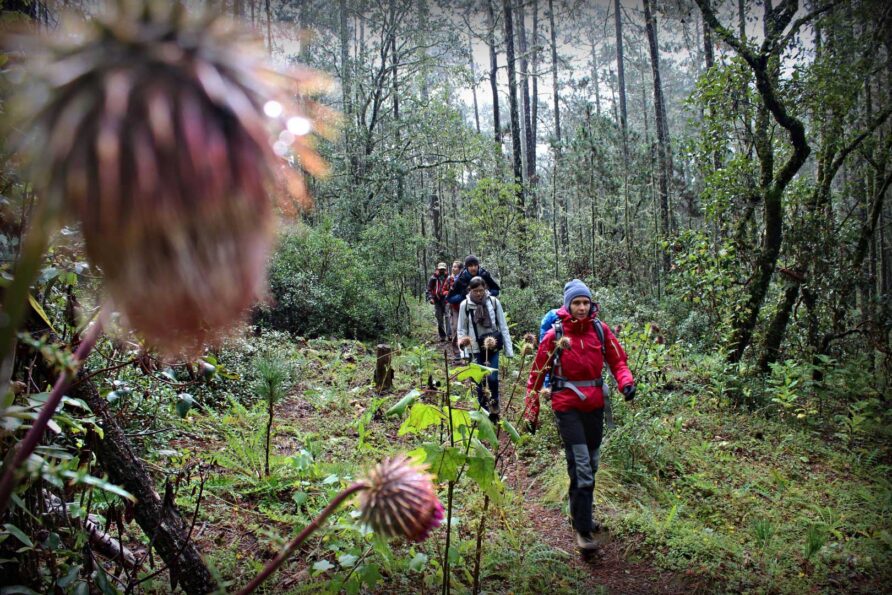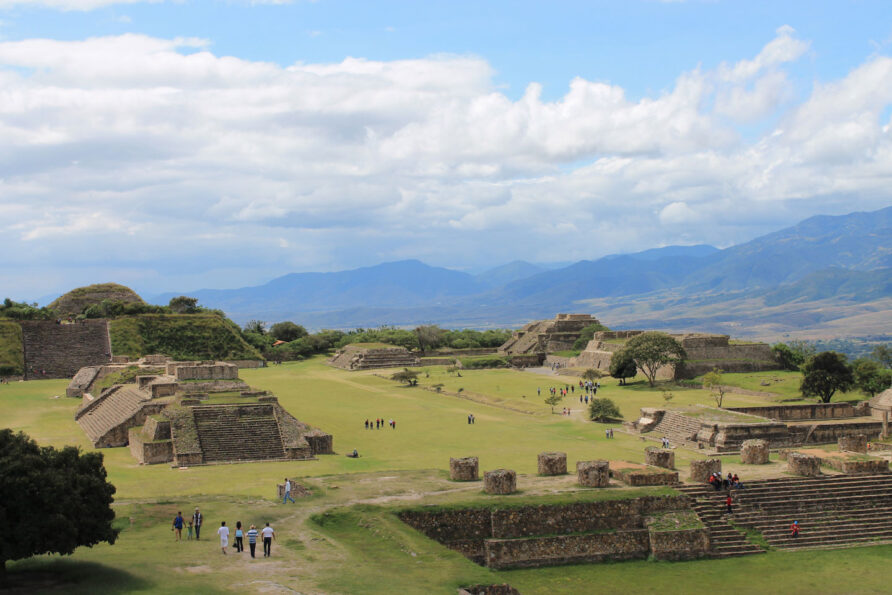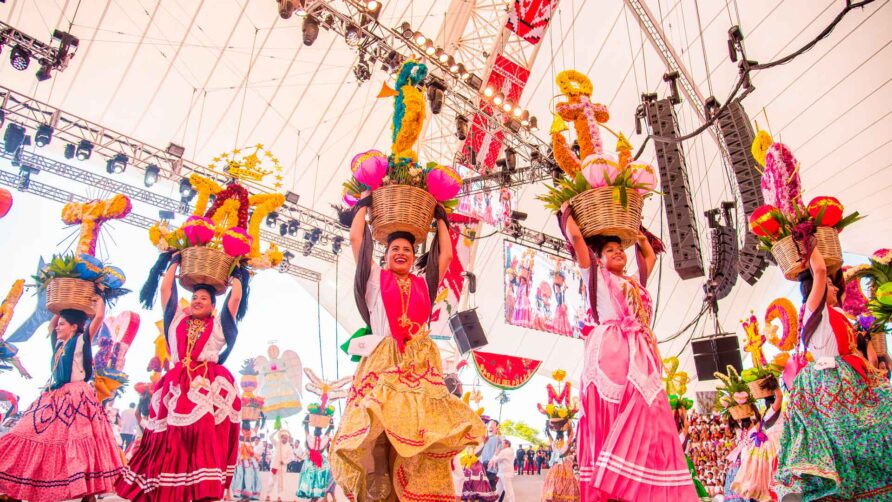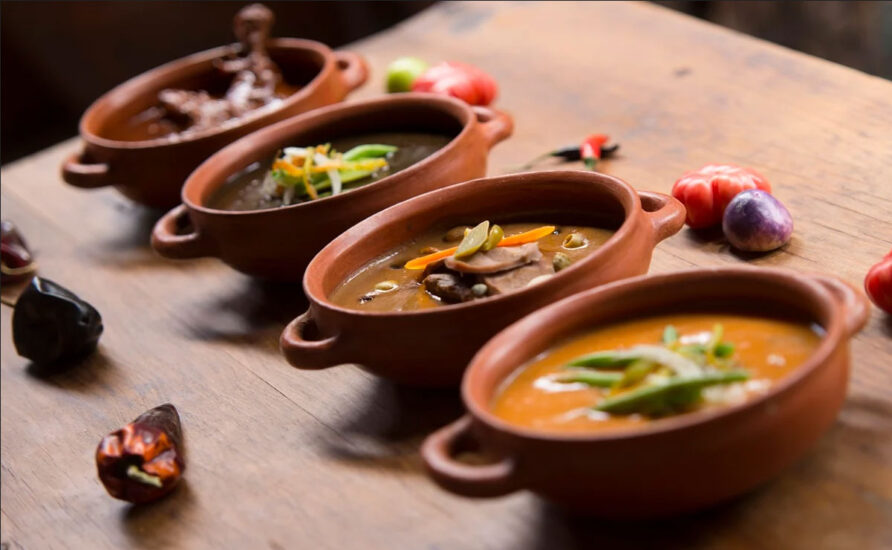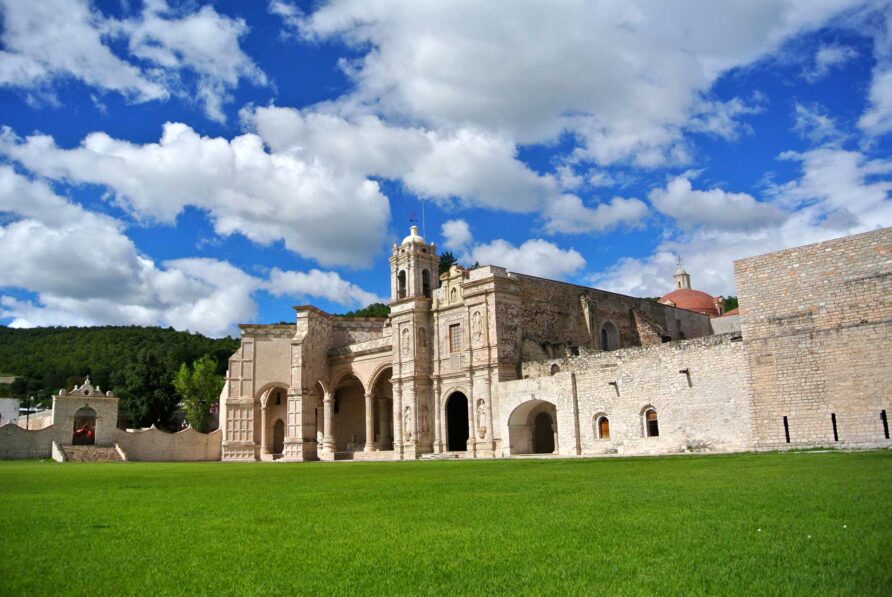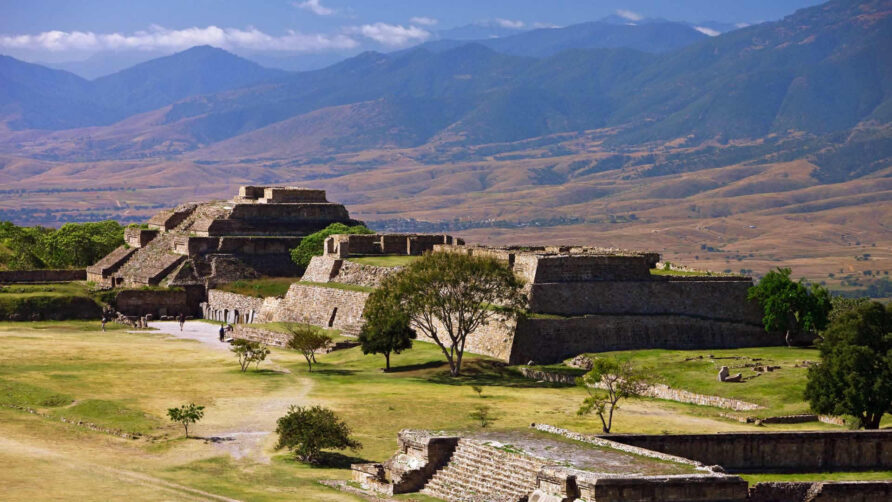Ro-House » Oaxaca »Crafts from Oaxaca
The special magic that the state of Oaxaca emanates attracts the attention of travelers from Mexico and around the world. Among many other reasons, this is because it is a traditional, mysterious place and strongly marked by the indigenous peoples who inhabit it. But it is also open to experimenting with new aesthetic and cultural trends. Thus, its vibrant crafts, its avant-garde visual artists, its colorful parties and its spectacular cuisine make Oaxaca an extremely attractive place.
In the center of the state is the City of Oaxaca, a fascinating and hospitable capital in whose surroundings various towns are located, each with its own personality and craft tradition, accompanied by their respective customs, festivals and dishes. The Magic Route of Handicrafts invites you to know part of the manual works of this immense state. Because the so special place that Oaxaca occupies in Mexico and the world is due to a great extent to the countless and magnificent hands of the artisans who with great sensitivity and creativity meticulously shape their dreams, illusions, aspirations and spiritual needs in pieces of clay, wood. , metal, stone, silk thread or cotton.

Magic Route of Handicrafts: art and multicolored magic
The proposed route is an invitation to: Encounter art and creativity embodied in the fine touches that, with love and dedication, the inhabitants of the six communities that make up the Magic Route of the Handicrafts. Witness the artisan processes of the great Oaxacan masters, who preserve and transmit techniques learned from generation to generation. His skill and talent have made the popular art of the towns of the Central Valleys shine, and have placed the name of Oaxaca very high, by taking the magic of its culture beyond its borders.
Get to know the communities that the route crosses, in which the different handicrafts - wood carving, green and black glazed clay pottery, silk and cotton thread textiles or pieces of cutlery -, whether utilitarian or ornamental, constitute a driving force fundamental in the family and community economy.Enjoy the delicious traditional gastronomy of the region, visit the museums and temples, share the simple life of the towns and, above all, fill your eyes and soul with the multicolored magic that arises from the wonderful the hands of Oaxacan artisans.

Teotitlán del Valle
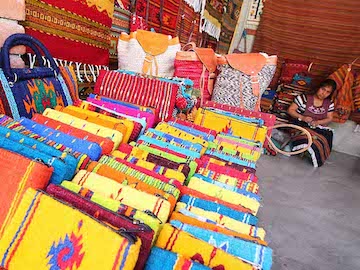
In Oaxaca the textile tradition has pre-Hispanic reminiscences that merged and enriched when the Spanish arrived; They brought the wool-producing sheep, mulberry trees, and silkworms, as well as the instruments to transform these fibers into yarns and fabrics.
The colonial looms operated by pedals and shuttles were faster than the backstrap looms that were known here, but the creative imagination of the Zapotec artisan made the looms a characteristic stamp where the technique, patience and dexterity with which they stand out. They make their handmade rugs.
Currently in Oaxaca the textile crafts from the different regions of the state are identified by their designs and colors of great originality, but in Teotitlán del Valle there are families that have been dedicated to this artisan activity for years. His technique and especially his love for textiles, have been transmitted from generation to generation.
The time to manufacture each mat can vary from fifteen days to several months, it is a one hundred percent manual process, and everything depends on the complexity of the work, the size and the design.
A rug from Teotilán del Valle is the result of the work and dedication of skilled artisans, who with their magical hands manage to transmit the love they have for this “land of gods”, as its name means in the Nahuatl language.
The process
First, the wool is carded and spun, the colors are elaborated, and according to the designs, the skeins of yarn are dyed in a tub of boiling water with the dye already prepared and an acid or lemon juice so that the color is impregnate and do not fade.
The colors with which they are dyed are a product of the same nature. Red colors are obtained from the scarlet or cochineal; the nopal insect, nocheztli, produces intense reds and purples. From the jiuquilitl or indigo blue is achieved. From the tishinda or sea snail, the purple and the huizache pod gives the black. The brown color is obtained from the walnut shell and the orange color is extracted from the marigold.
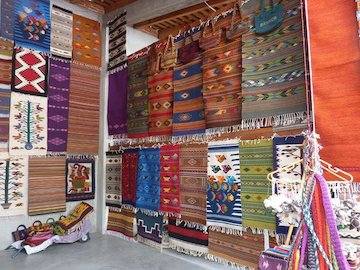
Balaa Xtee Guech Gulal Community Museum. The museum, whose doors opened in 1995, is made up of three rooms. In the first of them you will find vestiges found in Monte Albán I; the second is dedicated to the introduction of the wool rugs that are famous in Teotitlán; and the theme of the third is the traditional weddings of the area. It is a charming museum where various inhabitants of the community participated in its construction, research and creation.
Markets. The markets of Teotitlán are full of color and joy, both are located in the Historic Center, one of them famous for the characteristic rugs of the region and the other for offering the typical products and food. On the left side of the main church is the Handicraft Market, with sale of the famous handmade rugs made of sheep wool (dyed with natural dyes from plants and animals), bags, overflows, zarapes, hats, key rings and wool dolls. On the right side of the church is the Municipal Market with sale of fruits and vegetables from the region, the typical bread of the town, prepared snacks, among others. Tuesdays, Fridays and Sundays are Plaza Grande days, where all artisans from the valley come down to offer their products.

Santa Maria Atzompa
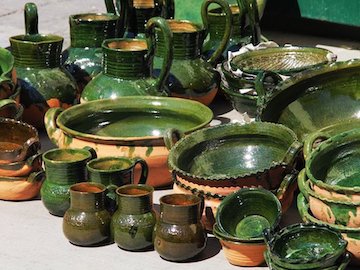
In this town, located 7 kilometers northeast of Oaxaca City, most of the population works with glazed green clay pottery, a trade inherited from generation to generation for several centuries. The process of elaboration of the showy pieces begins with the extraction of the mud in the mines of San Lorenzo Cacaotepec, a town located 4 kilometers from Santa María Atzompa.
Back in the patios of their houses, the artisans place it on a lathe that they turn with their feet, to later knead with their hands and gradually form the desired piece. To cut, scrape, sand and polish the pieces, they are helped with simple tools such as spoons, leather, tongs, stones and pieces of backpack. Once formed, the figures are left in the open for about a week, so that they will withstand the first firing in the oven. The characteristic green color of this ceramic is achieved, on the already fired clay, by applying greta, a powder that, mixed with water, is impregnated in each piece, which is baked again.
And with this laborious technique of glazed green clay, in Santa María Atzompa pots, pots, comales, jugs, pots and many other utilitarian and ornamental items are made. Among the latter, pottery decorated with pastillage stands out, a technique that consists of adding flowers and leaves to the vessels, which is known locally as "embroidering the clay"
Visit the great ball court in the archaeological zone of Atzompa. This satellite settlement of the Zapotec city of Monte Albán was built between 200 and 900 AD.It has a set of three ball game courts, one of which is 45 meters long, which makes it the largest in the area, including Monte Albán.
Get to know more than a thousand years of history exhibited in the Community Museum. The enclosure houses a collection made up of 98 pre-Hispanic pieces, divided into seven thematic nuclei: description of the site, cultural relationship between Monte Albán and Atzompa, the ancient Zapotecs and their relationship with the environment, the architectural style, the settlement pattern as a reflection of the social organization, worldview and Zapotec religion, the tombs of the elite and, finally, the pre-Hispanic ceramics.
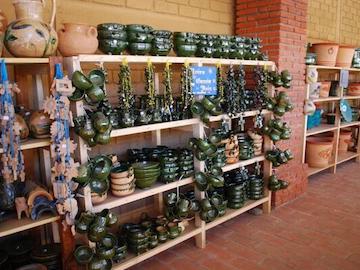
Be amazed by the simplicity of the tools and materials used to create the green clay pieces. It is fascinating to visit the work sites in the craftsmen's own homes and learn about the tools and materials they use to create each piece of green clay: spoons or smooth stones for polishing, pieces of leather to shape the handles, metal pliers. cut to scrape or plastic bags to strain the greta powder. The rudimentary utensils, needless to say, contrast with the finesse, details and crystalline sound of each work.
La Asunción craft market. Located in the center of Santa María Atzompa, it exhibits and sells a wide variety of handicrafts, mainly green glazed clay. The label system, which indicates the name of the artisan and the price of the piece, allows some of them to make sales while others are dedicated to making the pottery.
Señor del Coro handicraft market. In the twenty-one stalls that make up this market you can find an extensive collection of pieces as useful as they are beautiful: from large pots to small and detailed clay animals.

San Antonio Arrazola
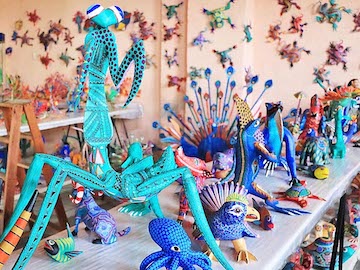
Popular in the Oaxaca region are alebrijes carved in copal wood. The elaboration of these crafts is the base of the economy of the towns of San Martin Tilcajete and San Antonio Arrazola, where many families work in the carving of figures that they later color with vinyl paint and sell in the squares, markets and workshops of the region.
Santa Cruz Xoxocotlán is a municipality in the State of Oaxaca that belongs to the Central Valley Region, and has some Municipal Agencies such as San Antonio Arrazola located 10 km from the road to Zaachila. Commonly known as «Arrazola», this place is famous for the manufacture of alebrijes: Mexican crafts invented by Pedro Linares López in 1936 in Mexico City.
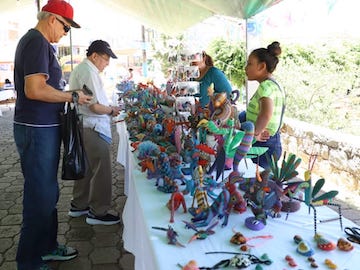
It is made with different types of paper or wood carved and painted in cheerful and vibrant colors. Most of the time they represent an imaginary animal made up of physiognomic elements from several different animals. Although several techniques can be used to make alebrijes, in San Antonio Arrazola wood carving is used, since it comes from the ancestral Zapotec era and is a knowledge that is transmitted from generation to generation.
In this place the ingenuity of the artisans is reflected in the copal wood, to create a fantastic zoology ... "Alebrijes" that are exhibited and sold in the artisans' own homes. Visit the Manuel Jiménez Museum-Workshop to appreciate or acquire any of these pieces of art.

San Bartolo Coyotepec
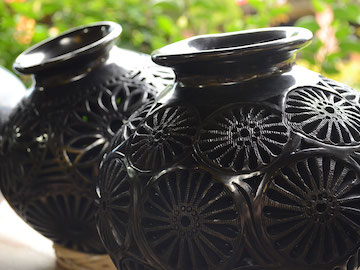
Located 13 kilometers south of the City of Oaxaca, this town whose name means "on the hill of the coyote" is known mainly because more than half of its population is dedicated to making black clay pottery, unique in the world. and unmistakable for its color and its brilliant finish.The black clay pieces from San Bartolo Coyotepec involve delicate work.
Unlike other types of ceramics, each work of this type takes a long time to finish. Once the clay has been extracted and prepared, the stages of modeling, drying, scraping and polishing follow, a phase in which each craftsman shapes his stamp through decorative incisions and detailed ornaments. The firing is done in a so-called "two-mouth" oven, also known as "reducing atmospheres", because the air inlets and outlets are covered when the pieces are well cooked.
Used since pre-Hispanic times, this process generates in the clay a physical reaction contrary to oxidation and produces a black or grayish color with a matte or glossy finish, a surprising silver sound when struck, and a resistance that allows it to contain liquids. . Once cooked, the pieces are removed the next day, washed, dried and ready to be used or displayed.
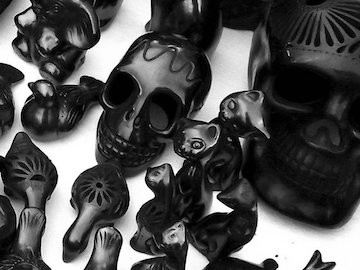
Admire the pieces of the State Museum of Popular Art in Oaxaca (MEAPO). This space, intended for the promotion and promotion of Popular Art of the state of Oaxaca, exhibits pieces by artisans from San Bartolo Coyotepec and many other communities of the Central Valleys, in addition to hosting and developing activities for the promotion of different artisan manifestations of the state.
Visit the artisan workshops. Most are small-scale and are installed in the homes of artisans, where you can learn about the process of making the various utilitarian and ornamental figures: jugs, vases, figures of women and virgins, chandeliers, skulls, as well like figures of animals.
Temple of San Bartolomé Apóstol. Built between the late seventeenth and early eighteenth centuries and dedicated to Saint Bartholomew the Apostle, patron saint of the place, this temple also protects the image of the Virgin of Candelaria, patron saint of artisans, for which its altar is adorned with pieces of black mud.

San Martin Tilcajete
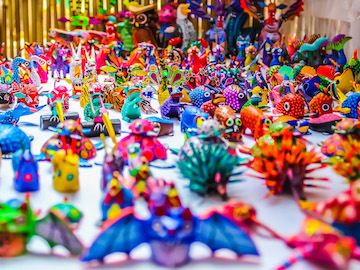
The famous alebrijes are made in this town located 23 kilometers south of Oaxaca City. Unlike those made with papier-mâché in Mexico City, these are carved in copal wood, and are born from dreams and the vast imagination of artisans, whose hands give life to these fantastic and unique beings, full of color and incredible details.
After imagining the final shape of the alebrije, the craftsman carves the wood and, with the copal resin itself, heals the imperfections. Then he immerses the piece in gasoline for a day, to get rid of insects in the wood, and thus ensure the high quality of the pieces that are painted after drying, using natural or commercial dyes of the most diverse tones and combinations.
Get inspired and let your own creativity flow. Any of the many family workshops in this interesting Oaxacan town can become a great place to unleash creativity by learning how to carve and decorate an alebrije according to your own ideas and fantasies.
Church of San Martín. This temple built in the 17th century protects the image of San Martín de Tours, patron saint of soldiers, weavers and textile manufacturers, widely venerated in the parishes of Europe and Latin America.
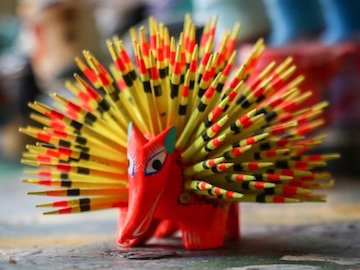
El Cajete. Emblematic place of San Martín that gives it its second name: Tilcajete or "black bowl", which is made up of til, "black ink" or "cochineal ink" and "bowl" which means mound of stones that surround a birth of water like a well or waterwheel. Its two wells previously supplied the community and it is said that upon the arrival of the Dominicans the water extracted from these was attributed curative properties.
Hill of María Sánchez. There is a great number of legends about this famous conical hill with very steep slopes, a slightly flattened summit, and a height of approximately 400 meters above the level of the Oaxaca valley. The few trees that populate it are thorns, copals and huntsmen, and its location is strategic to visualize the entire valley. It also has a huge cave, which is worth climbing on foot, on a tour that lasts approximately two hours.

Saint Thomas Jalieza
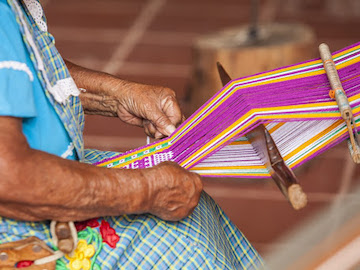
This town, located 25 kilometers south of the City of Oaxaca, is known for the creative talent of Zapotec women that adds to the mystical symbolism of their worldview, in a fusion of extraordinary beauty that is discovered in each of its pieces. backstrap loom. This type of loom, of pre-Hispanic origin, owes its name to the fact that one of its parts is tied to the waist of the artisan with a leather girdle called mecapal, and another to a tree or wooden post.
It is also known as a two-bar loom or otate loom, when its structure is made up of two rods of that plant. With simple movements that seem to contradict the dexterity of their hands, the weavers gradually make incredible multicolored pieces emerge from the cotton threads: table runners, shawls, bags, backpacks, purses, bracelets and even dolls that they keep in its plot pre-Hispanic symbols of multiple meanings.
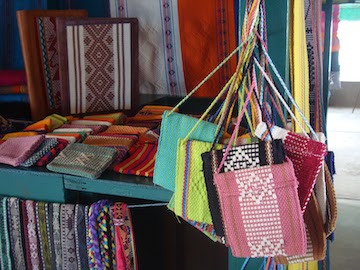
Witness the waist weaving process. During the visit to the workshops that operate in the houses of the population, it is possible to witness the process of weaving the waist, with the danger of succumbing to the desire to acquire the delicate embroidered pieces.
Admire and buy local textiles. In the handicraft market known as El Higo, located in front of the local temple, as well as in the Tourist Parador of this community, artisans make and sell irresistible huipiles, blouses, bags and bracelets made on waist looms.
The Letter Stone. This stone, in which pre-Hispanic inscriptions from the time of Monte Albán II are observed, is found on the slopes of the Yaveo hill, where it is believed that a human settlement existed. One of the beliefs is that it is a gateway to the underworld.

San Antonino Castillo Velasco
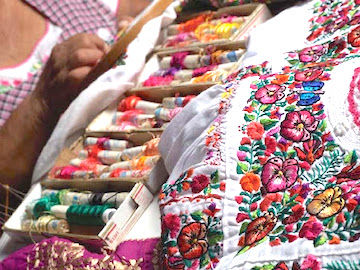
In this community located 33 kilometers south of the City of Oaxaca, the art, patience and ingenuity of the artisans is reflected in the delicate textiles made with thread-silk and cotton, particularly in dresses and blouses. The traditional garment that is made in this place is known as the San Antonino Dress, and is characterized by its fine multicolored embroidery that has its origin in the indigenous clothing of the women of the Central Valleys.
In addition, various pieces of reed basketry are made here - tall stands, cages, baskets or napkin holders - and handicrafts made and decorated with the small "immortal flower", also known as immortal flower, because it is born and dies without losing its petals, or its color. These pieces include a great variety of religious objects and detailed scenes of Oaxacan daily life that year after year compete in the “Night of rabanos"
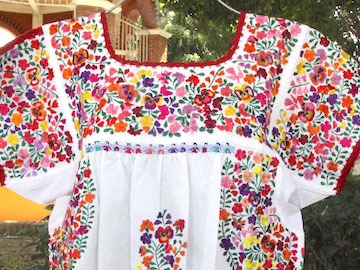
It contemplates the elaboration of the embroidery «Make me if you can». It is worth visiting the family workshops and admiring the detail involved in making the “Make me if you can” embroidery that adorns huipiles and blouses. The artisans gladly show the entire process of making textiles, basketry or articles made with the "immortal flower."
Try the exquisite yellow empanadas. The Nueva Democracia and Macedonio Alcalá markets are the right places to try the traditional yellow mole empanadas, with shredded chicken meat and coriander, or buy flowers planted in local plots.
Church of San Antonino Obispo. In this seventeenth-century building, built in honor of the town's patron saint, old pieces of religious art stand out, including splendid paintings and images carved in wood.

Ocotlán de Morelos
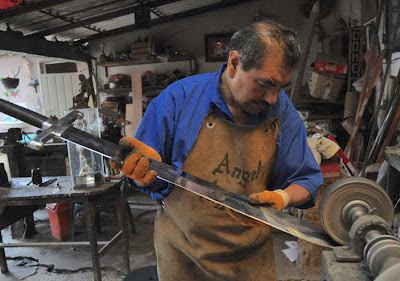
Located 33 kilometers from the City of Oaxaca, Ocotlán de Morelos is one of the most important districts in the Central Valley region.
In the heat of the forge and in the midst of the rhythmic and incessant blow of the marro, it is closely known how the ocoteco artisans turn crude metal into beautiful and sharp blades, tempered by fire. Swords, knives, letter openers, daggers and sabers, bear inscriptions of names or popular sayings, and their polished handles, made of leather, bone, bronze or horn, show the painstaking meticulousness of this art, centennial legacy of Toledo steel. traditionally used for the manufacture of swords and other weapons of war.
In addition, in Ocotlán de Morelos you can admire the various pieces of utilitarian and ornamental ceramics made with clay of different colors. Although to a lesser extent, reed basketry is also worked and baskets, fruit bowls, jewelry boxes and lamps are made, as well as various leather and leather articles - such as saddles, suitcases, purses, belts and jackets - and shawls, dresses, huipiles and blouses made of blanket and embroidered with silk thread.

Taste regional delicacies and shop for handicrafts at the Morelos Municipal Market. Every Friday the traditional plaza or tianguis day takes place, which is the occasion to try local snacks made with the freshest ingredients and, of course, buy handicrafts.
Get to know the work of the muralist Rodolfo Morales inside the former convent. This museum is located in the old Dominican convent, in the space adjacent to the Santo Domingo de Guzmán temple. It has a music library, a library and a room dedicated to religious art, which has images of Catholic characters from the district.
Temple and former convent of Santo Domingo de Guzmán. Dominican convent from the 16th century where the chapel of the Lord of the Sacristy stands out, decorated with neoclassical details.

More Tourist Attractions in Oaxaca
Oaxaca City, the state capital, is famous for its architecture and rich cultural traditions. Oaxaca also has a splendid and varied cuisine and a spring climate throughout the year. UNESCO declared the city a Cultural Heritage of Humanity. Oaxaca is the most diverse state in Mexico. It has peaks that reach more than 3,000 meters in height, caverns that are among the deepest in the world, pristine beaches, secluded forests and sunny valleys. Oaxaca is rich in traditions and customs and has the largest ethnic population in Mexico.
The name mezcal has its roots in one of the ancient native languages of the area and translates as 'agave (also known as maguey) cooked'. Although pre-Hispanic Oaxaqueños used maguey to make pulque (an undistilled alcoholic beverage), it seems that the real advances in mezcal production occurred when the Spanish arrived in Oaxaca; by bringing with them their knowledge of distillation processes.
In the state of Oaxaca there are many customs and traditions throughout the year, and within the state, said that they have the same purpose of celebration but with different things, in fact from one region to another or even more from one town to another, the Customs vary for perhaps details but that is what makes them authentic. Oaxaca has deep-rooted customs and traditions. All the holidays are celebrated, the profane and the religious ones. The festival calendar is extensive due to the diversity of ethnic groups, which they still conserve.
Oaxaca's culinary tradition is extraordinary and deeply rooted. There are fourteen different ethnic groups, with their own dishes. It is an area of incomparable wealth for the tourist interested in gastronomy, ethnology and culture in general. Oaxaca is the land of mezcal, tlayudas and the famous seven moles. You have to dedicate several days to it. Oaxacan gastronomy is one of the cultural manifestations that identify and define its people, due to its variety, richness and complexity that have been preserved through the centuries. The best way to enjoy Oaxacan food is by tasting it, from the “strong” dishes that are used to enjoying at lunchtime; like the traditional Oaxacan snacks that can be enjoyed at any time of the day.
The Santo Domingo Cultural Center is a cultural complex that is located in what was one of the most important convents in the colony. It is a large convent in which the Museum of the Cultures of Oaxaca, the Fray Francisco de Burgoa Library and the Ethnobotanical Garden have been established. The Néstor Sánchez Public Newspaper Library is located in a building that is part of the complex but dates from the 19th century. Apart from all these institutions brought together, the Santo Domingo Cultural Center has multipurpose spaces in the former convent, in which temporary exhibitions, conferences, courses, book presentations and concerts are held, among many other activities.
An ideal space for Alternative Tourism, Oaxaca offers activities such as walking, mountain biking, rappelling, climbing, zip-lining, horseback riding, observation of flora and fauna and more, in close contact with nature. The visitor can also witness the various aspects of local life, savor the gastronomy and enjoy the warmth of its people, as well as an offer of accommodation in hotels, ecotourism cabins, local houses or excellent camping areas. In its varied geography, it brings together not only a vast biodiversity, considered among the largest in the world, but also insurmountable cultural and ethnic riches, and the most different and beautiful natural settings.
Oaxaca is famous throughout the world for its archaeological sites and the history they keep. Discover Monte Alban, Mitla, Yagul and more of these remote sites, which have made Oaxaca a World Heritage city, according to Unesco. The original Zapotec and Mixtec peoples of Oaxaca lived in the cities and religious centers of the valley of this city until the time of Spanish colonization. Today, there are still vestiges of these towns and places where you can meet them.
The Guelaguetza is an ancient tradition with pre-Hispanic roots related to agricultural ceremonies of gratitude to the gods for the arrival of the rains and the lifting of the harvest at the end of July and is the largest festival in Oaxaca. La Guelaguetza is a celebration of gratitude for the arrival of the rains and the harvests, in which representatives from all regions of the state gather in the capital to share their culture through dances, crafts and food.
The vast Oaxacan cuisine is distinguished by its tradition and the use of regional ingredients. Not for nothing has it positioned itself as the Best Tourist City in the World and the Best Gourmet Destination. In the presentation of the 2021 edition of The Mexico Gastronomic Guide "The Great Restaurants of Mexico" 278 restaurants located throughout the Mexican Republic were recognized, on this occasion, there were 16 Oaxacan restaurants that were placed in the list .
In Oaxaca we are proud to have 5 communities that have been awarded the title of Magic Towns of Mexico, a Magic Town is a town that has symbolic attributes, legends, history, transcendent events, everyday life, in short magic that they emanate in each of their socio-cultural manifestations, and that today mean a great opportunity for tourist use. The Magical Towns Program contributes to revalue a group of populations in the country that have always been in the collective imagination of the nation as a whole and that represent fresh and different alternatives for national and foreign visitors.
Monte Albán is the most important archaeological zone of the Oaxacan entity, of unique regional importance due to the religious, political and economic control that the Zapotec state exercised over the population of the Valley of Oaxaca for more than thirteen centuries. It has been named by UNESCO as Cultural Heritage of Humanity along with the city of Oaxaca on December 11, 1987. The heritage of the Zapotec world reaches us through the magnificent archaeological sites designed in the Valley of Oaxaca. Of these, the city of Monte Albán stands out for its enormous importance as an economic, political and religious hub (it was the first urban complex in Mesoamerica); by its extension, almost as big as the current capital of Oaxaca; and for its long life, started around 500 BC and concluded around 850 AD
The beaches of the coast of the state of Oaxaca are among the most beautiful and complete in Mexico, thanks to a developing tourist infrastructure and the rich gastronomy of the Pacific. Along the 533 kilometers of coastline, the beaches of Oaxaca offer a wide variety of activities for lovers of water sports: snorkeling, diving, sport fishing, surfing, among others ... there is something for everyone!
Places such as Puerto Escondido, Mazunte, Zipolite, Carrizalillo, Puerto Ángel or the beaches of Huatulco will offer you the possibility of contemplating beautiful sunsets, delighting in intense adventure tourism or witnessing the exciting release of newborn turtles.
The City of Oaxaca is a destination that offers a great variety of tourist attractions and charms that leave anyone surprised. However, there are other places that are also worth knowing and are in the surroundings of the city, in whose surroundings various populations are located, each with its own personality and artisan tradition, accompanied by their respective customs, festivals and dishes. .

Guided Tours in Oaxaca


